Select an image to learn more.
IN THIS EPISODE of Curious Objects & the stories behind them, part two of our special coverage of the 2018 Winter Antiques Show, Benjamin Miller gets the dish on mace-like molinets, impeccably-preserved highboys, gem-encrusted jewelry, and five-legged card tables from proprietors of Bernard & S. Dean Levy, Nathan Liverant and Son, Stephen and Carol Huber, James Robinson, and Ben’s very own S. J. Shrubsole, among others.
Listen to the episode on iTunes, SoundCloud, or right here, using the SoundCloud plugin below. Don’t have time to listen to the complete episode? Pick an object that piques your interest from the grid above to listen to the segment of the podcast relating only to that piece.
Benjamin Miller: Welcome back to Curious Objects & the stories behind them, brought to you by The Magazine ANTIQUES. I’m your host, Ben Miller. Before we start, I’d like to bring your attention to America’s oldest auction house, Freeman’s. Located in Center City, Philadelphia, Freeman’s has been telling the story of valued objects and collections since 1805. Today, Freeman’s believes in a unique standard of one-on-one service, and their tradition of excellence has benefitted generations of private collectors, institutions, advisors, estates, and museums. This April, Freeman’s will bring to auction the collection of Dorrance “Dodo” H. Hamilton. With works by Cezanne, Garber, and Audubon, the collection features fine European and American paintings, furniture and decorative arts, and jewelry from the venerable philanthropist and Philadelphia fixture. For more information, visit Freeman’s online at freemansauction.com.
This is part two of my double episode from the Winter Antiques Show at the Park Avenue Armory in Manhattan. I have another eight dealers for you this time, and a great slate of objects. Like always, you can see pictures online at themagazineantiques.com/podcast. And just a quick reminder: please send me your feedback at podcast@themagazineantiques.com. I’d really like to know what you’re enjoying about the podcast and what you might like to see me do differently, and of course suggestions for future guests. Also, a huge thank you to everyone who has left a rating on iTunes, that really helps me bring the show to new listeners.
Bernard & S. Dean Levy’s five-legged table
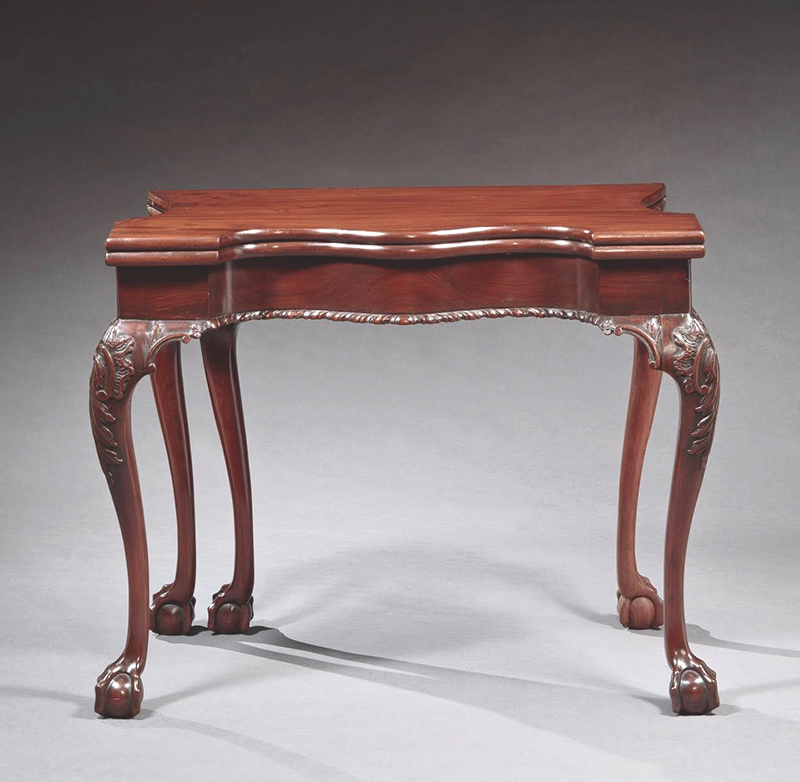
“Every top of every table made in New York—doesn’t matter who made them—is going to be exactly the same shape top. Somebody either had a template that was being shared or there was some guy making tops for these things.”
Benjamin Miller: We’re starting out today with an old New York firm called Bernard & S. Dean Levy. Frank Levy, one of its current owners, told me about a curious New York–made table from a famous group of furniture sometimes referred to as the Beekman Group. The Cliff Notes back story here is that the group was made for the Beekman family in the second half of the eighteenth century. It was only in the 1990s that a researcher named Lauren Brunk discovered a record naming the probable maker of the group, a fellow named William Proctor. You’ll hear Frank mention a Winterthur student researching Beekman—he’s talking there about Lauren. Let’s jump in.
We’re talking about a five-legged table. And why does it have five legs?
Frank Levy: That’s the question I was hoping you wouldn’t ask because we don’t really know. It is peculiar to New York, primarily. I think there are a couple of English examples that have been mistaken as New York that are out there, but it’s peculiar to New York in this period.
Benjamin Miller: Which period is that?
Frank Levy: This is the Chippendale period. So, these tables generally date from 1750 to 1775. What’s nice about the fifth leg is that that’s the swing leg. That’s the one that moves so that at all times there are four legs holding it up. So, when you look at it from a distance, if it’s open, you still see all the legs supporting the table. There’s not one—
Benjamin Miller: Because the cover, or the top, is hinged so that it can fold out to make a table twice the size of the original table.
Frank Levy: Exactly, a games table. And, actually, this one is hinged so that when you open it up there’s a felt or a baize on the interior . . . little cups, little scoops for your chips.
Benjamin Miller: People gambled on this table?
Frank Levy: People actually may have gambled on this table.
Benjamin Miller: I’m shocked.
Frank Levy: We think they played a game called whist, W-H-I-S-T.
Benjamin Miller: Sure.
Frank Levy: But I have no idea how that game is played. I mean, I know poker, I don’t know whist, so . . .
Benjamin Miller: Well, let’s stick to the table then, leave card games aside. What’s the material?
Frank Levy: The material is . . . the primary wood, or the wood that you see, is all mahogany, which had to be imported into New York to be made. The secondary wood, or the inside woods, the guts of it, are a combination. The back rail, the rail that swings, that allows the leg to move, is oak. And it’s oak because that’s a strong wood that can withstand all the movement and then the wooden hinge won’t wear down and then you start losing legs or having problems. There’s some tulip poplar in there, which is local to New York, and there’s a little bit of white pine as well.
Benjamin Miller: And there’s a group of tables that this belongs to, is that right?
Frank Levy: Yes. This is a table made in New York City and there are four main groups of tables made in New York City. This belongs to a group that used to be called the Beekman Group. There were a pair of tables made for the Beekman family that used to be at New-York Historical [Society]—they’re now in a private collection. They are made the same way this one is made. They all kind of look the same because every top of every table made in New York—doesn’t matter who made them—is going to be exactly the same shape top. So, somebody either had a template that was being shared or there was some guy making tops for these things. Not just the cabinetmaker making the case, but a top maker out there, one of those two possibilities. It . . . what’s happened since the Beekman Group was called the Beekman Group is [that] a Winterthur student went through the Beekman papers, which are at New-York Historical [Society] and are a treasure trove of information. She found a bill from the Beekman—not a bill, but sort of a receipt—from the Beekman family to a man named William Proctor for one card table, one china table, and, I think it’s . . . eleven Windsor chairs.
Benjamin Miller: Okay
Frank Levy: The Beekman pair would make, you think, well . . . there’s only one table there, but the Beekman pair are two very different tables, clearly made as a pair, to be next to each other, but made at two different times. So, the fact that they’re buying one table from this man Proctor, I think, means that he is the maker of this group.
Benjamin Miller: Yeah, yeah . . . oh, fascinating. Attribution in American furniture is always so difficult. It’s very interesting to have a little bit of documentation around this one. It’s a beautiful piece and I’m grateful to you for sharing it with us.
Frank Levy: Pleasure. Thanks for asking.
James Robinson’s jewel-encrusted Giuliano necklace
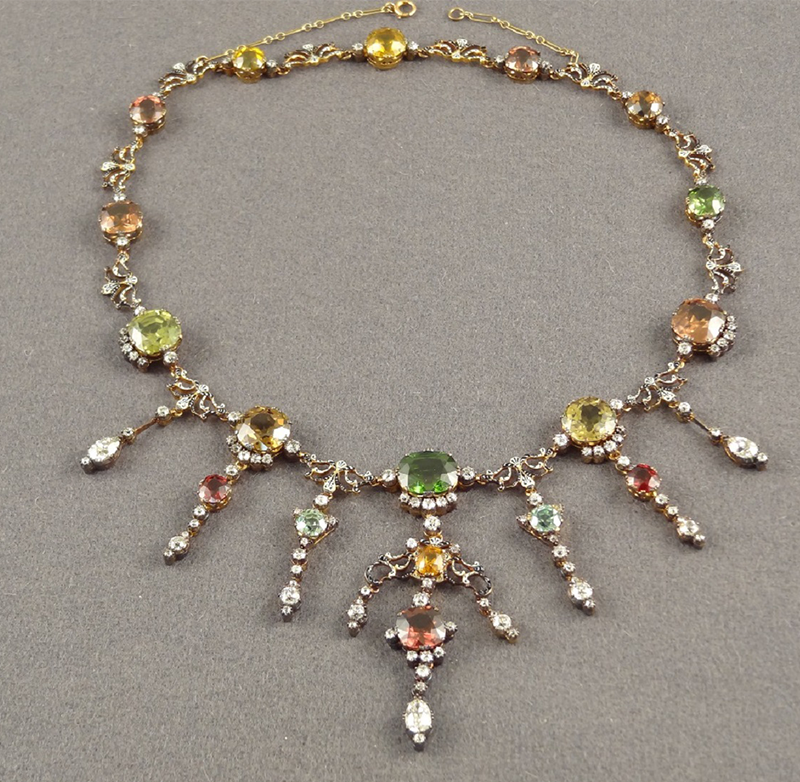
Victorian period black-and-white enameled 18-karat gold necklace set with zircons and diamonds by Carlo Giuliano, c. 1875.
“All of the elements of this piece fall together so beautifully: the proportions, the colors, the way they are varied yet they connect to each other.”
Benjamin Miller: Next up is the only piece of jewelry in today’s episode. You’ll hear us talk about the jeweler’s signature, which refers to a tiny mark either stamped or engraved on a piece of jewelry to identify the maker. Marks like this were rare in the nineteenth century, when this piece was made, and as you’ll hear, they can be an important feature to look at if you’re trying to determine whether a piece is authentic or fake. Here’s Joan Boening.
Joan Boening: I am fourth generation at James Robinson. We are a business that’s been around since 1912 and currently my son is also in the firm, so he’s fifth generation.
Benjamin Miller: And you’re here in New York?
Joan Boening: We’re here in New York. We’re at 480 Park Avenue which is at 58th Street.
Benjamin Miller: And we’re looking at a necklace and a brooch.
Joan Boening: A necklace and a brooch by Carlo Giuliano. It’s an exquisite piece of jewelry, the necklace, which . . . it’s unusual because it’s set with multicolored zircons and diamonds, as well as decorated in black and white enamel.
Benjamin Miller: It’s very splashy. The colors do make it a little fun.
Joan Boening: Exactly! It’s lots of fun and I think it’s quite wearable. But it kind of is an interesting piece because it’s unique. I’ve never seen another one quite like it, all of the elements of this piece fall together so beautifully: the proportions, the colors, the way they are varied but yet they connect to each other in a way that other jewelers weren’t able to do. He just had better foresight in terms of putting things together.
Benjamin Miller: And give us a time period here.
Joan Boening: Well, this particular piece dates from around 1875, and it actually . . . we purchased it from a woman back in the early ‘80s who came in . . . the piece originally was in a box. The box had a necklace and a blank space for a brooch and the woman said, “No, I don’t have the brooch I just have the necklace” and we purchased it and sold it to a collector and I said to him, “well, if, you know, by chance, the brooch ever shows up, of course I’ll call you,” never thinking that a few years later the lady’s sister would show up and say, “oh, my sister sold you a necklace a few years ago. I have the brooch.”
Benjamin Miller: Wow.
Joan Boening: So, I immediately purchased the brooch, immediately called my client, reconnected the two pieces. Unfortunately, the box was lost in a flood in their vault. I admonished him for not at least saving the box, as badly damaged as it was, because we also know that by having it in its original case . . . that would also increase its value.
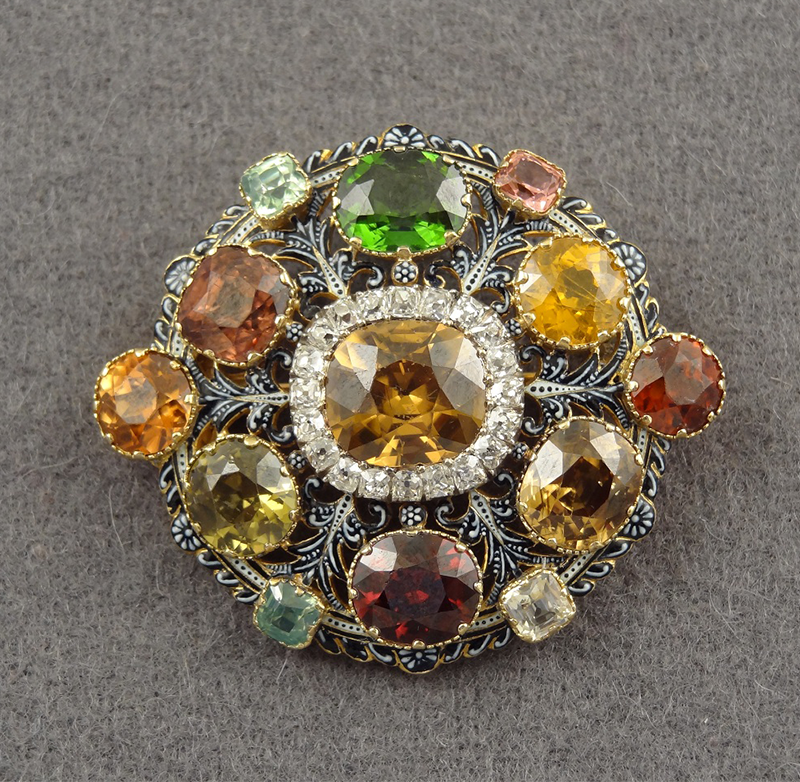
Victorian period black-and-white enameled 18-karat gold brooch set with zircons and diamonds by Carlo Giuliano, c. 1875.
Benjamin Miller: What else is there to say about this?
Joan Boening: Well, one of the rare things about it is not only the design of it and the wearability but the fact that it has five signatures.
Benjamin Miller: Five signatures?
Joan Boening: Five signatures.
Benjamin Miller: And how many signatures do you normally see?
Joan Boening: Normally, I’ve only seen one and I’ve only seen one other necklace that had two. One was on the clasp and one was on the front of the piece. I don’t know why this particular piece—other than that it’s wonderful—has five signatures, but it does make me wonder if many of the pieces began their life with more than one signature and if somewhere along the way something happened or they were taken apart and other pieces were recreated. I can’t confirm that, I just wonder why this piece . . . I’ve seen other wonderful pieces that he did that only had one signature.
Benjamin Miller: Because adding a Giuliano signature to an otherwise normal, ordinary piece would certainly add a lot of value.
Joan Boening: Would change its value completely.
Benjamin Miller: And is the signature a difficult thing to forge?
Joan Boening: Well, his signature is a “CG” which is cast on a small oval disk, so, my assumption would be that a good jeweler could probably do that but . . . it would probably be something that no one would want to try to do because if people got wind of the fact that there were four faked marks, this jewelry doesn’t carry enough cachet . . . it’s not like Cartier. People have to know who Giuliano is and have to understand his jewelry to—
Benjamin Miller: It’s a little bit academic.
Joan Boening: Exactly.
Benjamin Miller: And, so, it would be easier to take a marked link off of an existing piece and create a new piece around that.
Joan Boening: Exactly, exactly.
Benjamin Miller: Well, thanks so much for joining me.
Joan Boening: My pleasure. Thanks for coming to visit us at the show.
David A. Schorsch and Eileen M. Smiles American Antiques’ Nantucket lightship basket
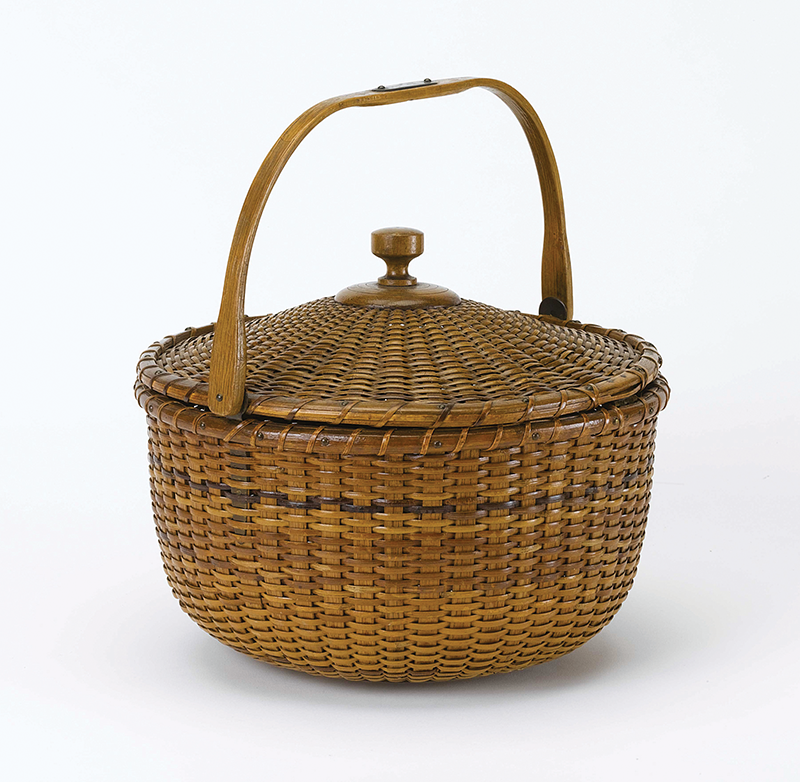
Lightship basket with hinged lid attributed to Arthur D. Williams, c. 1918-1926.
“99 percent of all Nantucket lightship baskets look like this without a lid. It’s this extra feature that distinguishes it among many, many thousands of baskets.”
Benjamin Miller: This next object draws us away from precious materials and the aristocracy and into the realm of the everyday—an object designed for practical use whose maker nevertheless invested great care into its crafting. Here is David Schorsch.
Benjamin Miller: The name of your firm is . . . ?
David Schorsch: It’s David A. Schorsch and Eileen M. Smiles American Antiques and we’re based out of Woodbury, Connecticut.
Benjamin Miller: And you’re coming down to New York for the show and you’ve brought with you some very interesting objects of an eclectic variety of origins. What would you say is the genre that you deal in?
David Schorsch: Well, we deal in high-end American folk art and it covers a variety of mediums from textiles to baskets to painted furniture, Pennsylvania German objects, folk paintings and folk sculpture. That pretty much is the overview of the material.
Benjamin Miller: And today we’re talking about a basket—
David Schorsch: And a piece of Shaker furniture!
Benjamin Miller: Oh, right. Very much in vogue these days. But we’ve decided to talk about a basket and this is a small basket. What is it, about a foot in diameter?
David Schorsch: It’s . . . well, you’re very good. It’s eleven and a half inches in diameter.
Benjamin Miller: Okay, okay. And it’s a circular form with a rounded bottom. It has a handle carved from a single piece of wood?
David Schorsch: Steam bent.
Benjamin Miller: Steam bent?
David Schorsch: Steam bent in order to achieve that. It’s probably an oak handle, oak as being a wiry wood like hickory or ash works very well to be steam bent.
Benjamin Miller: And it also has a cover that has a knob on the top of it.
David Schorsch: Made of sycamore. It’s turned sycamore. The bottom board and the finial are made of sycamore.
Benjamin Miller: And the body and the cover are both woven.
David Schorsch: Correct. This is what’s called, in the field, a Nantucket lightship basket. And many people may be familiar with Nantucket baskets because a kind of lady’s purse was developed in Nantucket—late ‘40s into the ’50s— became wildly popular, they still make reproductions today, [and] those were really invented and developed by a Filipino immigrant to the island named José Formoso Reyes. And Reyes took a basket like this, which was made earlier, in the classic style, and reinvented it in an oval shape with a hinged lid with a leather . . . woven leather thong hinges and [his design] often has a top with carved scrimshaw ivory ornamentation.
Benjamin Miller: Oh, right.
David Schorsch: Like a half of a sperm whale or a floral device.
Benjamin Miller: So, a much more elaborate object than what we’re looking at.
David Schorsch: And also designed specifically for the tourist trade in large quantities.
Benjamin Miller: Whereas this one would have been made for personal use?
David Schorsch: This was either made as a presentation piece by the maker or custom design[ed] because it’s very rare in this genre of Nantucket basketry to find one with a lid. So, the thing that makes this basket special, of course, is the beautiful craftsmanship and the design and so forth. But, you know, 99 percent of all Nantucket lightship baskets look like this without a lid. It’s that this has this extra feature that distinguishes it among many, many thousands of baskets.
Benjamin Miller: And it would have been used to carry around personal effects.
David Schorsch: Yeah, we don’t know. I’m not sure it was ever used, and it’s made by a maker called Arthur D. Williams, and he lived from 1865—I believe—to 1940. Anyway, what’s interesting about these baskets and how they derived their name is . . . Nantucket being located where it is, you know, there were a lot of shipping accidents so they actually had something called the South Shoal lightship, which was, in a sense, a portable lighthouse. It was a ship exclusively designed to hold a light. So, it was in a location where they could not have a lighthouse.
Benjamin Miller: Oh, right.
David Schorsch: So, they would anchor this ship with the light in this very dangerous area to protect incoming vessels. And sailors and workers there . . . stayed there for months on end. And sometime in the, I don’t know, 1860s, 1870s . . . and we’re not sure who—it may be Captain Ray (it’s a dispute among scholars as to who exactly invented the Nantucket light ship basket)—but they started creating these extremely finely woven baskets that have certain features that distinguish them from all other American-made baskets. What’s interesting about Nantucket baskets and for someone who might be an aspiring collector, is that this is a field where a new collector could begin buying one for under $1,000 and get into the field because these were made over successive generations. So, as they get newer, generally more affordable, and they’re still making them on the island today.
Benjamin Miller: Well, David, thanks so much for the education.
David Schorsch: My pleasure, you bet.
Barbara Israel Garden Antiques’ Villeroy & Boch stoneware maiden

Classical stoneware maiden by Villeroy & Boch, c. 1900.
“One of the reasons people collected statues that replicated ancient subjects was because they wanted to show that they were aware of history.”
Benjamin Miller: Picture yourself in an effete and refined Victorian garden. You see the manicured grass and pruned cyprus, marble stairs and fountains . . . and, of course, sitting atop walls and plinths, classical statues. Where did these statues come from and how were they made? My next guest gave me the inside scoop.
I’m here with Barbara Israel of Barbara Israel Garden Antiques and we’re standing in front of a very interesting statue, which almost looks as if it could be ancient Greek or Roman.
Barbara Israel: Well, she does imitate that—no question this is a classical figure—and she’s representing the applied arts. In her right hand she has a sculptor’s tool and in her left hand she has a palette, even with the little bits of paint left on it. And she is “the applied arts.” There were originally four of them that would have been “applied arts,” “industry,” “trade,” and “commerce,” and “science,” five of them.
Benjamin Miller: And she is not actually ancient.
Barbara Israel: No, she was made in the nineteenth century, or close to the end of it, at least, by a German company called Villeroy & Boch, and she is marked such on her base, which is something I care about enormously: knowing what these pieces are. Because garden pieces were made in replica, so, sometimes you just get something that floats in and it isn’t marked and it’s hard to figure it out.
Benjamin Miller: Oh, right. And what purpose was she made for? Purely decorative, to be placed in a garden?
Barbara Israel: Yes, she would have been exactly that. And she’s made of stoneware, so that is a hard-fired clay object and usually they fire it longer so it’s better in the winter if you’re in the Northeast, where we are, stronger and is less porous so you don’t have water leaking in and freezing and causing problems.
Benjamin Miller: When she was first made was it an expensive object? Was it something that only an aristocratic house would have had? Or was it made for a more popular market?
Barbara Israel: I think it would have been more on the elite side because it might not have been all that expensive compared to today’s prices of these things, but it would not have been something to have in a humble garden. One of the reasons people collected these sorts of statues that replicated ancient subjects was because they wanted to show that they were aware of history and they were erudite people.
Benjamin Miller: And I imagine the same could be said of some of your clients.
Barbara Israel: Yes, that’s true. I think, you know, just as . . . it’s . . . you’re proud to have an antique inside the house, people are really, really excited about having objects in their gardens, sculptural objects, and they add so much. Especially if there’s a new garden and you put an old statue in it, it makes the new garden look as if it’s been there for years.
Benjamin Miller: Well, thanks so much for talking to me, Barbara.
Barbara Israel: You’re most welcome, my pleasure.
Benjamin Miller: Let’s take a quick break and thank our sponsor, America’s oldest auction house, Freeman’s. Located in Center City Philadelphia, Freeman’s has been telling the story of valued objects and collections since 1805. Today, Freeman’s believes in a unique standard of one-on-one service, and their tradition of excellence has benefitted generations of private collectors, institutions, advisors, estates, and museums. Freeman’s holds more than two dozen auctions a year, across all collecting categories, from American Furniture and Decorative Arts to Modern & Contemporary Art. With international experience and comprehensive knowledge of market conditions, the specialists at Freeman’s work closely with consignors and collectors to offer unparalleled assistance in the sale and purchase of fine art, furniture, decorative arts, jewelry, books, and more. All of Freeman’s auctions and catalogues are published online. Their app, Freeman’s Live, is a complimentary service that allows users to bid in real-time from any mobile device or desktop. Freeman’s is currently inviting consignments for their Spring 2018 auction season. For those clients outside the Philadelphia area, Freeman’s regional representatives in New England, the Southeast, and West Coast areas are available to assist you with every step of the consignment process. Let Freeman’s help tell your story; for more information or to set up a complimentary and confidential auction valuation of a single object or an entire collection, please visit Freeman’s online at freemansauction.com.
Stephen & Carol Huber’s silk embroidery memorial
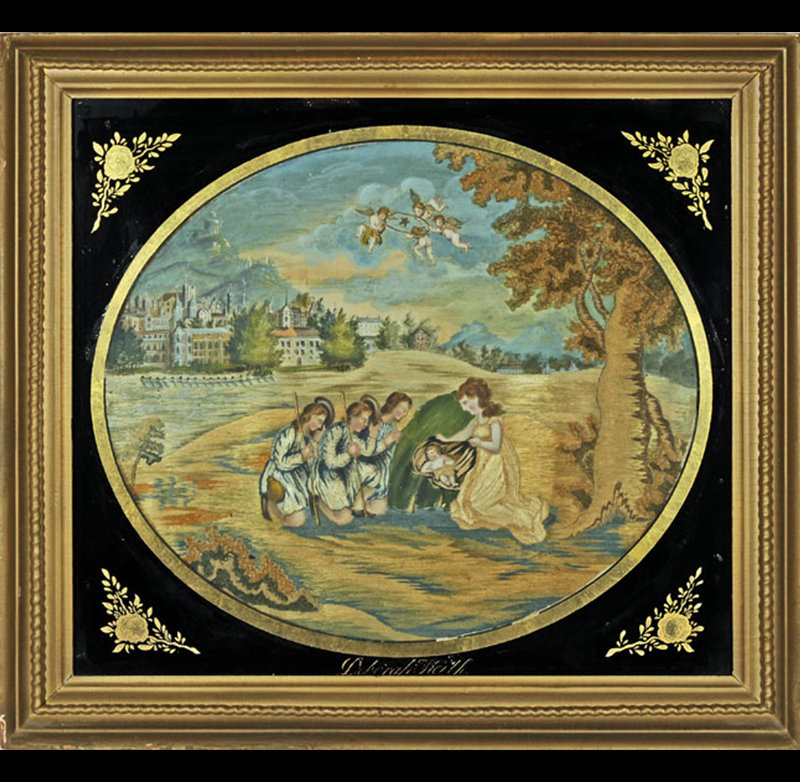
Embroidery by Deborah Keith, c. 1806. Silk and watercolor on silk in original gold-gilt wood frame.
“Silk embroidery memorials tend to be sweet, delightful, wholesome, beautiful works of art.”
Benjamin Miller: So many categories of collectible antiques are dominated by male craftsmen—furniture, jewelry, silver, fine art . . . but my next guest specializes in an area dominated by female artisans, namely, early American and English needlework. The great thing about needlework, to my mind, is that so many of these pieces tell their own stories, with evocative images and descriptive text. Here is Stephen Huber, of the Old Saybrook, Connecticut, gallery Stephen and Carol Huber.
Stephen Huber: These young girls would go to school—they were highly academically trained, but, also, along with that, they would take . . . do needlework, which is basically like taking art classes. So, this little girl, Deborah Keith from Massachusetts, in the early 1800’s, about 1806, did a beautiful little memorial that, if you glance at it, it looks like a Nativity scene, and it’s just the sweetest thing. It’s about a foot by a foot, roughly, and it has black eglomise glass around it, and the inner circle depicts three people that look like wise men—if you first look at it—kneeling down, and a little baby and then a woman on the other side. But what it amounts to, after doing some research on it . . . we discovered that Deborah Keith, who did this sampler, had a little baby sister that died and she was only an infant and this is depicting the sweetest little rendition of her three brothers paying homage to the little sister and herself. So, she’s kneeling on one side of the little baby and the three brothers are kneeling in parallel to each other on the other side and . . .
Benjamin Miller: And up in the sky . . . there are some figures there as well.
Stephen Huber: In the sky up above, right up above the little baby are four little angels holding a ring with a little star in the middle. It’s indicative of the little baby going to heaven—her soul—and it’s just . . . it’s very moving. And these girls tended . . . they would go to school and they would be expected to do a memorial and this is an example of that. It wasn’t necessarily because somebody recently died. Often they would do a memorial and dedicate it to maybe a little brother or sister that died. Maybe the girl was six years old when their brother or sister died, and maybe she’s doing this memorial when she’s sixteen years old and dedicating it to them. But, anyway, this whole silk embroidery memorial thing . . . they just tend to be sweet, delightful, wholesome, beautiful works of art. And this is just another example of that.
Benjamin Miller: There’s a fantastical-looking city in the background—is that supposed to depict a real place?
Stephen Huber: I doubt that city depicts a real place. It may be indicative of heaven. “In my father . . . there’s many houses”—I don’t know how that phrase goes—“in my father’s house there are many mansions,” or something like that. It may be indicative of that but it looks like a town scene but it’s a little heaven-ish looking, too, so I just don’t know the answer to that.
Benjamin Miller: Tell me a little about the research behind this piece. You have the name of the girl who created it, Deborah Keith.
Stephen Huber: We have the name and we knew where she was from, and we did genealogical research and discovered all the information that I was just relaying to you about having an infant sister that died and the three brothers. And it all clicked and was like, “Wow, that was an unusual one-off thing!”
Benjamin Miller: And it’s really a work of art. I mean, from a distance you could easily mistake it for a painting.
Stephen Huber: As a lot of these silk embroideries have that same scenario about them. You look at them and you think it’s a painting, you come up and you realize it’s needlework and watercolor on silk, and so, anyway, that’s about this piece.
Benjamin Miller: Well, thanks very much for joining me.
Stephen Huber: Okay, it’s been a pleasure. Thank you.
Nathan Liverant and Son’s Philadelphia Chippendale chair
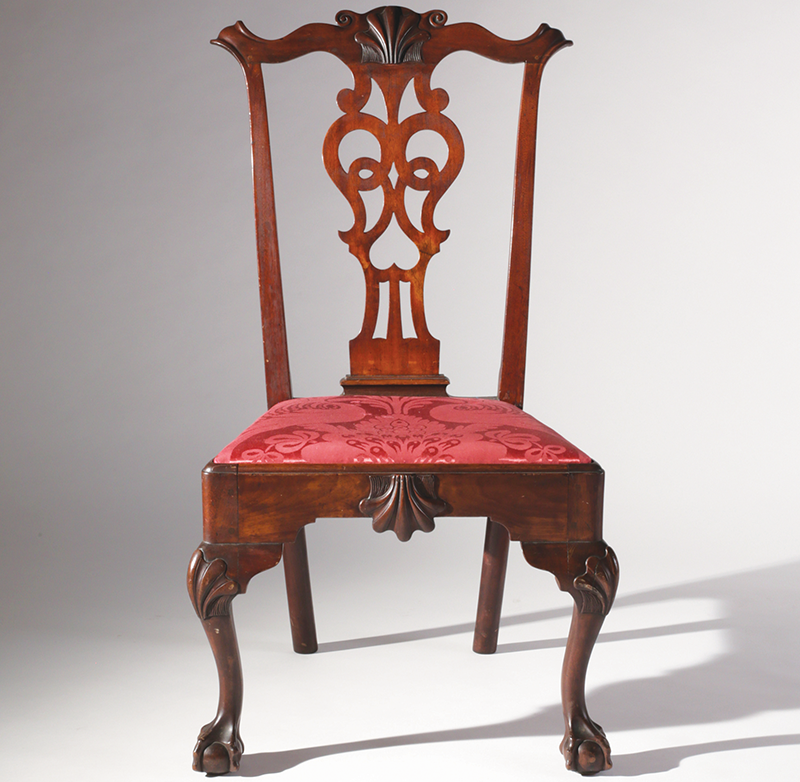
Philadelphia Chippendale side chair, maker unknown, 1760-1785. Walnut with maple slip seat frame.
“The idea with Chippendale design is to really create an interaction of flowing, graceful lines.”
Benjamin Miller: There’s no antique form that’s more iconic than a chair. My first ever guest on this podcast talked with me about a chair. It’s simple, intuitive, functional, and universal, but the way it’s designed and made can tell you a lot about the people who created it and used it. So I was excited to speak with Kevin Tulimieri of Nathan Liverant and Son about this eighteenth century Pennsylvania chair.
Benjamin Miller: And where are you based?
Kevin Tulimieri: We are out of Colchester, Connecticut.
Benjamin Miller: And you’ve brought with you a chair from Pennsylvania. And this dates to about what period?
Kevin Tulimieri: The chair dates from between 1765 to 1780. It’s a very exuberant Chippendale-style, so it really shows that mature version of the American interpretation of Chippendale.
Benjamin Miller: So, what exactly does that look like (for listeners who aren’t here right now)?
Kevin Tulimieri: Well, the idea with Chippendale design is to really create an interaction of flowing, graceful lines. You really look for an activated space, something where there’s serpentine curves and carving and the chair is really going into all different directions all at once. You have a serpentine-shaped crest with backwards-flaring ears, a central-carved shell that’s flanked by scrolled volutes that are deeply carved into the crest, and that’s supported by a serpentine-shaped and pierced splat that really has curlicues and returns and points and spurs and all sorts of decoration, but put together into a unified design.
Benjamin Miller: So what gives this away as an American chair as opposed to an English chair?
Kevin Tulimieri: Well, that’s a good question because the design and the name “Chippendale” comes from Thomas Chippendale, who was the English designer, and the splat is really right out of Thomas Chippendale’s design book. But this is an American version because it’s a little more simplified throughout the whole chair than what you would expect to see in England. And you combine that with the fact that it’s made out of native walnut—that was a primary wood used in Philadelphia and on certain parts of the East Coast, that is . . . has great character and quality, depth of color, and really fine grain.
Benjamin Miller: So, aside from the wood, which is local to Philadelphia, what else tells you that this is from Philadelphia?
Kevin Tulimieri: Well, you get that combination of the placement and style of carving of the shells, the combination with the shells and the scrolled volutes. And I say “shells,” plural—this chair is also known as a four-shell chair, and you have one shell carved in the crest, one shell carved in the center of the front seat rail, and then two shells carved one on each knee of the cabriole legs. So that particular design layout of the shells and placement throughout the chair is particular to Philadelphia.
Benjamin Miller: Do you know anything about the provenance of the chair?
Kevin Tulimieri: We don’t know, unfortunately, we don’t know where this chair came from, but it was made in Philadelphia by one of their skilled craftsmen. We don’t know who owned it, but it was certainly a wealthy and well-established family that was purchasing their furniture in the latest fashion in that mid- to late-eighteenth century time.
Benjamin Miller: Is it comfortable to sit in?
Kevin Tulimieri: Oh, why don’t you give it a shot? You can tell me. I mean, they did design these for sitting and for use in the household and a good place to sit and have dinner.
Benjamin Miller: Not too shabby. This is going to force me to adopt the good posture that my grade school teachers always failed to instill in me.
Kevin Tulimieri: You do tend to sit up straight and correct.
Benjamin Miller: Well, Kevin, thanks so much for talking to me.
Kevin Tulimieri: It’s been my pleasure. Thanks for stopping by.
Jeffrey Tillou Antiques’ Chippendale bonnet-top highboy
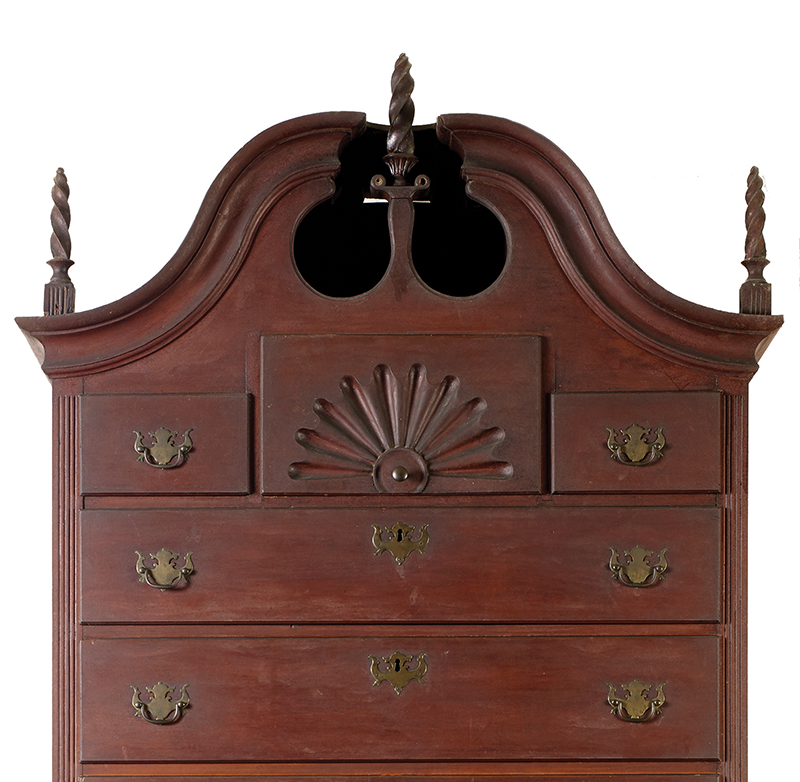
Chippendale bonnet-top highboy, maker unknown, c. 1783. Photograph by Ellen McDermott.
“It has original finish, original brass, and it’s just one of those rare outliers to find a piece that has never been touched.”
Benjamin Miller: We talk a lot in the antiques world about provenance—after all, half the fun of an antique is the connection you can feel with its past owners. Every little fact you can turn up about an object’s history—even if it’s only where and when it was made—makes it that much more compelling. The eponymous Jeffrey Tillou of Jeffrey Tillou Antiques brought two pieces to the show that share a remarkably complete provenance; in fact, they’ve been together since birth. I’ll let him tell the story.
Jeffrey Tillou: So, the two pieces I have in the booth that are highboys are both from the same family. They were made in Woodbury, Connecticut, in about 1783, and have remained in the Stiles family ever since. So right off the bat to have two pieces with the same provenance in the booth—
Benjamin Miller: That’s incredible provenance!
Jeffrey Tillou: Yeah. The highboy which is illustrated in The Magazine ANTIQUES—and the one that’s in center in the booth—is most notable for its state of preservation. It has original finish, original brass, and it’s just one of those rare outliers to find a piece that has never been touched. So, coupled with the provenance, the rarity of having a piece remain in the same family is a great opportunity for a museum or a great collector to own one of, I think, the better pieces I’ve seen on the marketplace.
Benjamin Miller: Absolutely. And, so, physically, it’s an imposing piece. Quite large. And the pediment has some interesting spiral . . .
Jeffrey Tillou: Right.
Benjamin Miller: . . . pieces. How would you describe those?
Jeffrey Tillou: Well, the few distinct features are that the plinth, the center plinth has a little scrolled . . . scrolled plinth on the top below the center finial. The other curious things about these pieces are the secondary woods. They’re all white oak, which is sort of not commonly seen in other New England pieces.
Benjamin Miller: Yeah! Any idea why white oak might have been used?
Jeffrey Tillou: Just native wood to that area in Woodbury.
Benjamin Miller: Yeah. And, sorry, what was the primary wood?
Jeffrey Tillou: Primary wood is cherry. Most—again, native wood—most of these pieces in western Connecticut are of cherry.
Benjamin Miller: What elements are more specifically regional versus more broadly American?
Jeffrey Tillou: Well, for more rural-area cabinetry you’re getting away from maybe sort of the center shops in the cities which will clearly have more uniformity with the shells. Up here in Woodbury in western Connecticut as you can see you have two different shells from top to bottom, and what I would call a lobed shell because the rays are rounded at the ends and the shell below is a little tighter. Again, one of the distinct features with this is that the rays are coming out of a center circle rather than just a point. But the other wonderful things about Connecticut furniture in general is that they carry on a whole different form in elements that you don’t see in, like, Boston, New York, Philadelphia furniture.
Benjamin Miller: Well, it’s had 250 years in a happy home; I hope it finds another one soon.
Jeffrey Tillou: Thank you.
S. J. Shrubsole’s mace-like molinet

Molinet by Anthony Nelme, 1719.
“The purpose of a molinet is to stir hot chocolate . . . but when this piece came up for sale in a small auction in the countryside in England it was catalogued as a mace.”
Benjamin Miller: I owe my next and last guest a special thank-you, because when I’m not podcasting, I’m actually working for him. He’s been extremely supportive of the podcast, and while I know I’m biased, I have to say that he’s also a pretty good antiques dealer. It’s the last interview you’ll hear from the Winter Antiques Show, but it was actually the first one I recorded there.
Oh, are we live now? Hi, Tim. Do you want to introduce yourself?
Tim Martin: Sure. My name is Tim Martin and my company is S. J. Shrubsole. We’re silver dealers and jewelry dealers on 81st Street in New York.
Benjamin Miller: And, for the record, would you state the relationship between you and your interviewer?
Tim Martin: Oh, and Ben is the Director of Research at the above-mentioned firm.
Benjamin Miller: And don’t think just because you’re my boss that I’m going to go easy on you.
Tim Martin: I would have no such expectations.
Benjamin Miller: What are we looking at today?
Tim Martin: We’re looking at a rare George I molinet by Anthony Nelme.
Benjamin Miller: What is a “molinet”?
Tim Martin: Well, a molinet is effectively a whisk—if you want sort of the nearest analogy to contemporary kitchen implements. It is a long piece of silver with a wooden handle at one end and these sort of fins or pierced . . . well, actually a simple molinet simply has four fins at the bottom and really not much else. This particular molinet, which is a very, very unusual and very, very fine molinet has at the bottom . . . I think it’s six pierced fins which are shaped and pierced out with sort of scrolls and little floral flourishes and they are . . . the reason I make the analogy with a whisk is that the purpose of a molinet was to stir up hot chocolate.
Benjamin Miller: How old is this piece?
Tim Martin: It was made in 1719.
Benjamin Miller: And what’s unusual about this as opposed to other molinets?
Tim Martin: Well, basically, it’s the size. It’s really colossal. In fact, kind of amusingly, it came up for sale in a small auction in the countryside in England, and, you know, like a lot of people, the auctioneer didn’t know what it was. But, interestingly, he probably went online and looked for pictures of similar things and so catalogued it as a mace, which is typically a fairly massive piece of ceremonial plate that was carried in processions and has a roughly similar form.
Benjamin Miller: Have you ever used it as a mace?
Tim Martin: I haven’t, although sometimes I’ve been tempted to smite you with it.
Benjamin Miller: I think we’d better leave it there. Thanks, Tim!
Tim Martin: You’re welcome. Thanks.
That’s it for today, and that’s the end of my coverage of the 2018 Winter Antiques Show. These episodes were a lot of fun to put together, and I’m grateful to all the dealers who took the time to talk with me. I’m also grateful to you, for listening. I’ll be even more grateful if you subscribe, leave a rating on iTunes—which takes all of about ten seconds, you can do it right now!—and if you send me your feedback to podcast@themagazineantiques.com.
Today’s episode was produced and edited by Sammy Dalati. Our music is by Trap Rabbit. And I’m your host, Ben Miller. Thanks for listening.
For more Curious Objects with Benjamin Miller, listen to us on iTunes or SoundCloud. If you have any questions or comments, send us an email at podcast@themagazineantiques.com.
